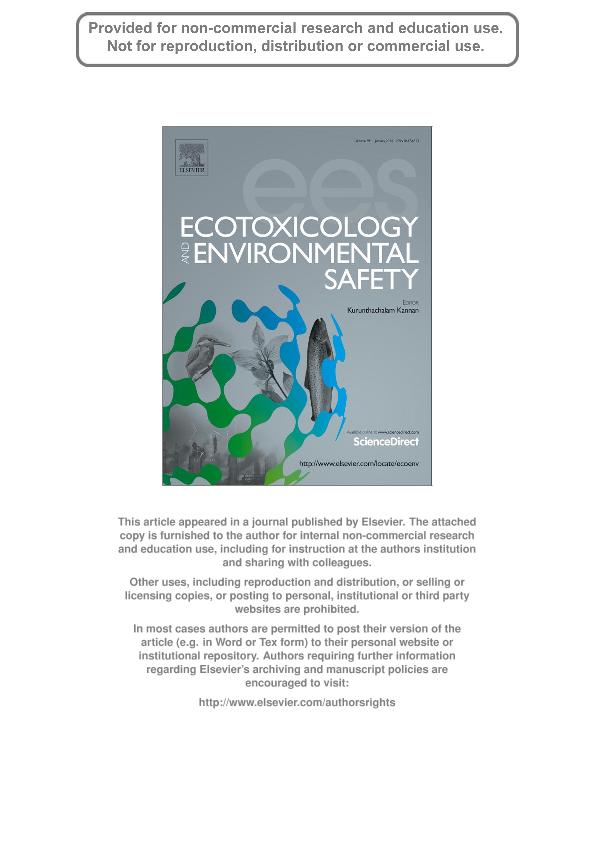Mostrar el registro sencillo del ítem
dc.contributor.author
Silva Barni, María Florencia

dc.contributor.author
Gonzalez, Mariana

dc.contributor.author
Miglioranza, Karina Silvia Beatriz

dc.date.available
2018-01-24T18:22:19Z
dc.date.issued
2014-01
dc.identifier.citation
Silva Barni, María Florencia; Gonzalez, Mariana; Miglioranza, Karina Silvia Beatriz; Assessment of persistent organic pollutants accumulation and lipid peroxidation in two reproductive stages of wild silverside (Odontesthes bonariensis); Academic Press Inc Elsevier Science; Ecotoxicology and Environmental Safety; 99; 1-2014; 45-53
dc.identifier.issn
0147-6513
dc.identifier.uri
http://hdl.handle.net/11336/34437
dc.description.abstract
Persistent organic pollutants (POPs) in streamwater can sometimes exceed the guidelines values reported for biota and human protection in watersheds with intensive agriculture. Oxidative stress and cytotoxicity are some of the markers of exposure to POPs in fish. Accumulation of organochlorine pesticides (OCPs), polychlorinated biphenyls (PCBs) and polybrominated diphenyl ethers (PBDEs) as well as lipid peroxidation (LPO) was assessed in wild silverside (Odontesthes bonariensis) from maturation and pre-spawning stages sampled in a typical soybean growing area. Pollutants were quantified by gas chromatography with electron capture detection and LPO by the method of thiobarbituric acid reactive substances. Concentrations of POPs were in the following order: OCPs>PCBs>PBDEs in all organs and stages. Liver, gills and gonads had the highest OCP concentrations in both sexes and stages with a predominance of endosulfan in all samples. Matured individuals, sampled after endosulfan application period, showed higher endosulfan concentrations than pre-spawning individuals. The predominance of endosulfan sulfate could be due to direct uptake from diet and water column, as well as to the metabolism of the parent compounds in fish. The prevalence of p,p′-DDE in liver would also reflect both the direct uptake and the metabolic transformation of p,p′-DDT to p,p′-DDE by fish. The highest levels of PBDEs and PCBs were found in gills and brain of both stages of growth. The pattern BDE-47>BDE-100 in all samples corresponds to pentaBDE exposure. In the case of PCBs, penta (#101 and 110) and hexa-CB congeners (#153 and 138) dominated in the maturation stages and tri (#18) and tetra-CB (#44 and 52) in pre-spawning stages, suggesting biotransformation or preferential accumulation of heavier congeners during gonadal development. Differences in LPO levels in ovaries were associated with growth dilution and reproductive stage. Differences in LPO levels in gills were related with pesticide application periods. As a whole, endosulfan, a current-use pesticide, constituted the main pollutant found in wild silverside reflecting the intense agriculture activity in the study area. Moreover endosulfan was positively correlated with LPO.
dc.format
application/pdf
dc.language.iso
eng
dc.publisher
Academic Press Inc Elsevier Science

dc.rights
info:eu-repo/semantics/openAccess
dc.rights.uri
https://creativecommons.org/licenses/by-nc-nd/2.5/ar/
dc.subject
Organochlorine Pesticides (Ocps)
dc.subject
Polychlorinated Bipheniyls (Pcbs)
dc.subject
Polybrominated Diphenyl Ethers (Pbdes)
dc.subject
Lipid Peroxidation (Lpo)
dc.subject
Silverside
dc.subject
Reproductive Stage
dc.subject.classification
Meteorología y Ciencias Atmosféricas

dc.subject.classification
Ciencias de la Tierra y relacionadas con el Medio Ambiente

dc.subject.classification
CIENCIAS NATURALES Y EXACTAS

dc.title
Assessment of persistent organic pollutants accumulation and lipid peroxidation in two reproductive stages of wild silverside (Odontesthes bonariensis)
dc.type
info:eu-repo/semantics/article
dc.type
info:ar-repo/semantics/artículo
dc.type
info:eu-repo/semantics/publishedVersion
dc.date.updated
2018-01-24T14:55:49Z
dc.journal.volume
99
dc.journal.pagination
45-53
dc.journal.pais
Países Bajos

dc.journal.ciudad
Amsterdam
dc.description.fil
Fil: Silva Barni, María Florencia. Consejo Nacional de Investigaciones Científicas y Técnicas. Centro Científico Tecnológico Conicet - Mar del Plata. Instituto de Investigaciones Marinas y Costeras. Universidad Nacional de Mar del Plata. Facultad de Ciencia Exactas y Naturales. Instituto de Investigaciones Marinas y Costeras; Argentina
dc.description.fil
Fil: Gonzalez, Mariana. Consejo Nacional de Investigaciones Científicas y Técnicas. Centro Científico Tecnológico Conicet - Mar del Plata. Instituto de Investigaciones Marinas y Costeras. Universidad Nacional de Mar del Plata. Facultad de Ciencia Exactas y Naturales. Instituto de Investigaciones Marinas y Costeras; Argentina
dc.description.fil
Fil: Miglioranza, Karina Silvia Beatriz. Consejo Nacional de Investigaciones Científicas y Técnicas. Centro Científico Tecnológico Conicet - Mar del Plata. Instituto de Investigaciones Marinas y Costeras. Universidad Nacional de Mar del Plata. Facultad de Ciencia Exactas y Naturales. Instituto de Investigaciones Marinas y Costeras; Argentina
dc.journal.title
Ecotoxicology and Environmental Safety

dc.relation.alternativeid
info:eu-repo/semantics/altIdentifier/doi/http://dx.doi.org/10.1016/j.ecoenv.2013.10.012
dc.relation.alternativeid
info:eu-repo/semantics/altIdentifier/url/https://www.sciencedirect.com/science/article/pii/S0147651313004375
Archivos asociados
